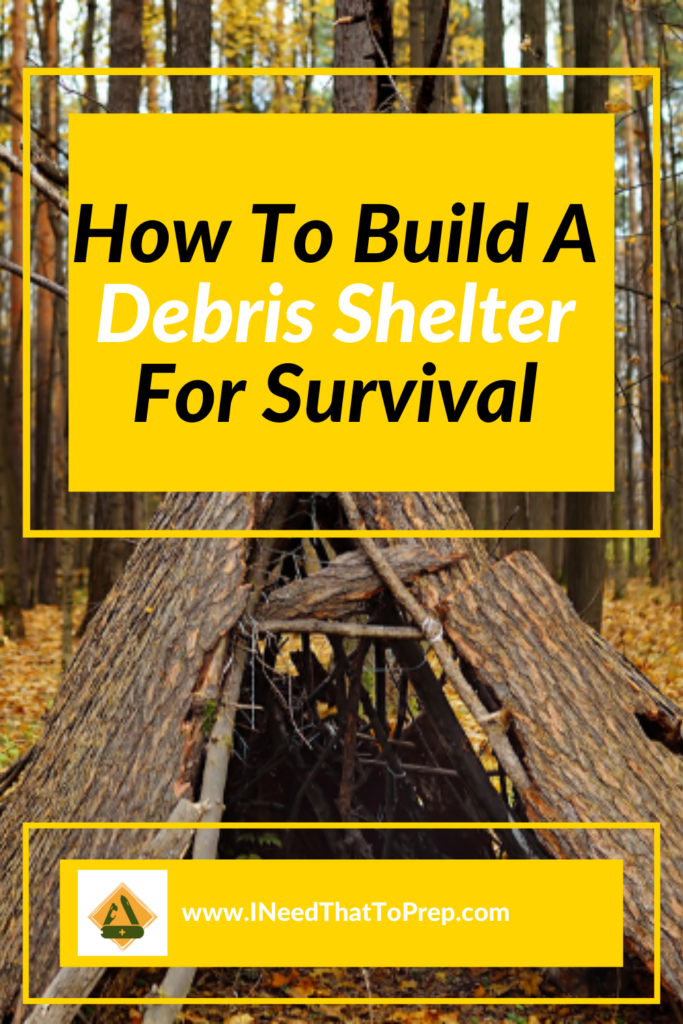Last Updated on April 26, 2023 by Lisa Vargas
One of the scariest scenarios you might play out in your mind is freezing to death. Hypothermia is not a joke. It is a frightening way to go. It involves confusion, disorientation, pain, uncontrollable shivering, poor motor skills, and finally death. One of the best things you can do to prevent this is to learn how to build a debris shelter.
Hypothermia can set in from cold temperatures, from being wet, or from a combination of the two.
Any survival expert will tell you to build a fire if you are at risk of hypothermia.
However, fire is not always an option. If you have no fire building tools or all of the firewood in the area is wet, you may have to do without. This makes shelter that much more important.

How To Build A Debris Shelter
Below you will find out how to build a debris shelter with little or no effort. It really comes down to common sense and the location of where you are at the moment you need the shelter. Whether will play a part as well.
A Cautionary Tale Of Building A Debris Shelter In The Woods
I can assure you that relying upon a debris hut is risky. If you build it the wrong way, it could be your undoing. On my very first winter survival challenge I learned this lesson the hard way.
I built a debris hut to stay warm, but I also planned to build a fire if possible. I spent most of my first day in the wilderness gathering firewood, but it snowed all day. Everything was wet.
I put together a quick debris hut but did not spend much time stacking up the insulating materials. As the sun went down, it became apparent fire was not going to happen.
The temperature plummeted and the wind picked up. The thin walls of my half-hearted shelter were doing no good as the wind whipped right through. I also kicked down part of my shelter as I tried to get comfortable.
The temperature was now at -1F. I tried moving around to get the blood pumping, but it was only a temporary relief. I pulled out my emergency blanket, but with little insulation from the ground it did not help.
I noticed when walking around that I kept forgetting which way it was to the shelter despite clear footprints in the snow. Finally, at 1am I checked my body temperature and I was just above 95F.
I was forced to tap out to avoid hospitalization. To this date it is the only time I have had to bail on a challenge. This just goes to show how important it is to build your debris hut correctly.
In this article, we will cover how a debris hut may save your life and also the proper way to build one.
How A Debris Shelter Works
Debris hut shelters are unique in that they are designed to work without a fire. This particular shelter is built to keep you alive by holding in your body heat like a sleeping bag.
However, it is built with only natural materials for insulation. The build is similar to a lean to in that it can be assembled quickly with nothing but a knife. That is where the similarities stop.
While a lean-to should be positioned to block prevailing winds with the one-sided roof, on a debris hut your feet should face prevailing winds so gusts roll off of both sides of the shelter.
Also, because you are using your body heat to warm up the air inside the shelter you should keep it as small as possible. The more air volume you have inside the shelter, the colder it will be.
Step 1: How To Build A Debris Shelter For Survival
You will need to start by finding a flat area with as little exposure to wind as possible. Clear out any rocks or other debris in the area. The best spot is one that is close to lots of fallen dead wood and insulating materials. Find a ridge pole about 10 feet long.
You will then want to find two support poles about four feet long, preferably with a ‘Y’ at one end so they interlock. Sharpen the other end of each support pole so it can be shoved into the ground.
Position the two support poles against each other at a 90 degree angle. Then lay one end of the ridge pole one top of the support poles with the other end resting on the ground.
If you have cordage you will want to use it to lash these poles together. You do not want the frame falling apart in the middle of the night.
Step 2: Construct Your Debris Shelter Bed
Next, you will want to construct your bed. Because the space is so small, raised beds are out of the question. You will want to just pile up insulating materials and then lie on them to pack them down.
Focus primarily on where the core of your body will be lying, as this is the area where body heat is most concentrated. Keep piling and packing materials until you have at least four inches of compacted insulation.
You can use dry leaves, dry grasses, or spruce boughs.
Step 3: Build The Sides Of Your Debris Shelter
You will then want to build the sides of your shelter. Gather up as many straight poles as you can varying in length from one foot to four feet long.
Start leaning the poles against the ridge pole with the longest ones being at the entrance and the shortest leaning where your feet will be. Try to get these poles as close together as possible so the insulation does not fall in.
Step 4: Insulating Your debris Shelter
Then, start stacking up insulation on your frame. You will want to start at the base of your diagonal poles and work your way up to the top of the shelter.
Then start back at the bottom again and keep increasing the insulation layer by layer. Pay close attention to the top of the shelter as this is where the majority of the warmth will escape.
You want to build up the insulation until it is at least four feet thick. Only then can you be sure that you will stay warm enough and also keep out any rain or snow.
My suggestion is generally to keep adding insulation until you are completely out of daylight. There is no need to collect firewood or to start a fire, so you might as well make the shelter as warm as possible.
Step 5: Build The Door To Your Debris Shelter
Finally, you will want to build a door at the entrance. You can pull a large hiking pack into the opening to help block the wind, but a door will work better.
Start with three poles each being about four feet long. Lash them together in the shape of an equilateral triangle. Then use cordage or vines to weave a mesh across the inside of the triangle.
I like the holes in the mesh to be no more than three inches across. Lay the door down flat and pile up insulating materials on the mesh you wove.
Finally, get more cordage or vines and weave across the top to hold everything together.
There is no need to attach the door to the shelter. Your best bet is to just set the door next to the opening. Get down on your hands and knees and back your way into your shelter.
If you made it small enough, you likely will need to get down on your belly for the last few feet. Get as far back into the shelter as you can without kicking it and knocking it down.
Then, pull your door in place to seal it off. Pay close attention to your bedding so you do not kick it all down near your feet.
Most of it should be up at your core and head. Once you get comfortable, try to stay still so you do not do any damage to the structure.
What Materials Do You Need To Build a Shelter?
There are several different materials you will use when building a debris shelter. A lot of it will depend on your circumstances and where you are at the time.
Items such as leaves, small sticks, nylon, paracord, plastic, and tarp can provide great materials for building a shelter.
How Do You Insulate A Survival Shelter?
When it comes to insulating your survival shelter the best materials are things like grass, bark from trees, pine needles and other wooded materials. Any type of fiberous material works well for this purpose too.
How To Build A Shelter Quickly?
You only need a few materials to build a shelter quickly. You first need to find three longer “poles” or tree branches approximately 8 feet long, and sharpen them with a knife at one end as these will be your framework.
Then, take those three tree branches and place them into a tee-pee-like shape and take some coradiage and tie it around the top to bind the structure together more securetly.
Next, grab a rain-proof tarp and start fitting it over your frame. Now ideally your tarp will have the precut holes so that if it’s windy you can peg it to the ground with other sticks. If not, use rocks around your area to anchor the tarp.
Final Thoughts
Nobody wants to survive the night on body heat alone. However, you may not have any choice. The debris hut is your ultimate plan B if you cannot get a fire going.
Because this debris shelter is the only thing keeping you warm enough to survive, it is that much more important that you build it properly.
As always, get in some practice building debris huts in your back yard or on a hiking or camping trip. Try sleeping in a debris hut when the temperature is not too cold.
This will give you a feel for exactly how the shelter works and how to build a debris shelter. You want to be able to execute this build quickly and efficiently if you are going to survive the night without a fire.
